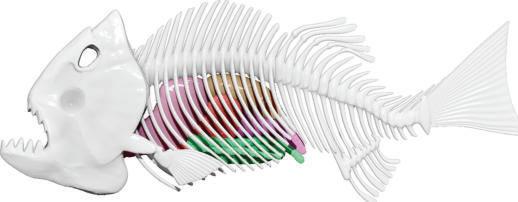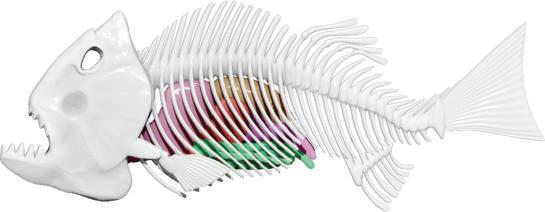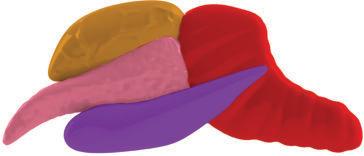PIRANHA



















Your piranha is ready to dissect right out of the box. Simply peel back the plastic film, remove the piranha from the mold, and place it on to the dissecting table (see figure below).
Keep the piranha mold in a safe place. You will need it for molding future piranha.
Now that you have laid out your piranha like the figure to the right, you can use your provided scalpel and probe to cut away sections of the skin to reveal the internal organs and skeleton of your piranha. Usually the first cut should be in the middle of the ventral side (underside) of the piranha beginning just below the back of the jaw line all the way to the caudal (tail) end of the piranha. Side incisions may be made to the side of the midlife incision distally (toward each side) to allow a flap of skin to be laid back to expose the position and location of the internal organs.
First Cut
We recommend reading the manual as you dissect your piranha so you can learn about exciting facts about piranha anatomy.
Here are the major bones of the piranha which you will explore in your “dissection”.
Pectoral Fin
Tail Ribs
Anal Fin
Figure 1
Fish are vertebrates, so they have a skeleton that includes a spine and a skull. A skeleton shapes, supports, and protects the soft parts of the fish's body, such as the organs and muscles. Fins and a tail are a part of a fish's skeleton that grows within the skin. The study of bones of fish is more difficult than in other vertebrates. Fish skeletons are made up of many more bones. For example, humans have 28 skull bones and a fossil fish was found with more than 150 skull bones.


When you cut through the artificial skin of the Piranha fish, you will find it very similar to a real one. Piranha skin is very thin and covered by circular colorful scales. Fish skin is an external protective surface. It acts as a cover that separates its soft organs from the external environment. Skin and scales together have a lot of vital functions. Many species use it to take oxygen from water directly, mainly when the fish are young. They also help the fish to feel any movement in the surrounding water which helps them know the direction and strength of current. Also through the help of skin and scales, fish can feel the motion of a prey; guess the location of an obstacle or predator; and stay connected with their groups. The beautiful circular scale has an unusual shape and buildup that gives the Piranha fish high flexibility. Scales are bright and mirror like to help them hide from predators.
Heads of fish are unlike most terrestrial vertebrates. Most fishes have heads able to expand so that they can eat through suction. Their vertebral columns have a high lateral flexibility to give them the power to move in variant currents. Like humans, fish have a hard skull to protect their brains. The skull encloses and protects the brain and most of the sense organs. The jawbones of a fish work like hinges to open and close the mouth. The Black Piranha has the strongest bite force recorded for bony fish. Piranha fish jaw bones are so strong, that they can crush a human hand in 5-10 seconds.

The herculaneum is a bony cover that lies directly below the head. It is very imporatant as it protects the delicate gills.
The tail is made up of thin, rod-like bones. These bones are joined together to give the tail its flattened shape. Fish use their tails to move through the water. Fish tails move side to side.


Piranhas have fins to help them control their movements. The fins are paired (two identical on both sides) and unpaired, and are named for the areas where they are inserted on the body. The fins on a fish's back are called dorsal fins. They are made up of long, rod-shaped bones that make the fin stiff. The dorsal fin stops the fish from rolling over as it swims. The pectoral fins of a fish are supported by thin, rod-like bones. These fins on either side of the body, help the fish turn left and right. The pectoral fins tilt slightly, like the flaps of an aircraft wing. Tilting the fins makes the fish swim up or down, or steer to one side.
The Piranha fish has a mouthful of triangular, blade-like teeth. The top and bottom teeth work together like scissors to cut up food. It eats fruit and seeds as well as other fish. A group of piranha can quickly devour larger prey by neatly chopping it into bits. Since they are such active choppers, a piranha has to replace its teeth all of the time. Their teeth, luckily, grow in four sets. These sets are replaced about every 100 days.
The spinal cord is made up of a bundle of nerves that sends messages around the fish's body to and from its brain. The spinal cord is protected by the backbone. A fish's backbone is also known as its spine.

The heart is the organ that pumps blood throughout the body, delivering oxygen and digested nutrients to the cells of various organs. It transports waste products from the cells to the kidneys and liver for elimination. In fish, the circulatory system is a single circuit, with a 2-chambered heart, unlike the typical 4-chambered heart found in humans. From the fish’s atrium, blood is pumped into the ventricle of the heart. From the ventricle, blood is pumped to the gills where gas exchange takes place. Carbon dioxide (CO2) is expelled and oxygen (O2) is taken in. This re-oxygenated blood then flows on to the rest of the body’s tissues and organs removing carbon dioxide and replacing it with life-giving oxygen. Blood is finally pumped back to the heart’s atrium chamber where the process begins again.

The stomach is often referred to as the gut, and is where food is digested and nutrients absorbed. By examining stomach contents, one can learn a great deal about fish feeding habits. Knowing what a specific fish species eats can also help with bait selection.
Kidneys are organs that filter liquid waste from the blood. The kidney is also extremely important in regulating water and salt concentrations within the fish's body. This allows certain fish species to exist in freshwater or saltwater, and in some cases both.
Stomach Kidney Liver Reproductive OrganThe liver has many digestive and storage functions. One function is the production of bile, a solution which breaks down fats in the intestine. The liver also stores fats and carbohydrates, destroys old blood cells, maintains proper blood chemistry, and plays a role in nitrogen waste removal.

The intestine is primarily an organ for absorbing nutrients into the bloodstream. The larger its internal surface, the greater its absorptive efficiency. Piranhas have a large surface area of the intestinal walls by having numerous folds and villi (fingerlike projections), somewhat like those in humans. Undigested substances are passed to the exterior through the anus.

Figure
Liver Intestine
The lateral line runs down the length of a fish’s body. It is made up of a series of microscopic holes located just under the scales of the fish. Lateral line is a primary sense organ, as it can sense low vibrations in the water, and is capable of determining the direction of their source.
The brain is the organ that controls the rest of its body. The brain is responsible for all the body's movements.
Gills are feathery arches along the side of its head. They contain blood vessels that absorb oxygen from water.
The olfactory bulb is an organ located in the forehead of fish that receives information about odors detected by cells in the nasal cavity. The axons (smell receptors) extend directly into the olfactory bulb, where information about odors is processed.
Figure
All fish possess a sense of smell. Paired holes called nares, are used for detecting odors in the water, and are located on a fish’s snout. Experiments have shown that piranhas have a very sharp sense of smell as it helps them find their food in the often murky waters of their native habitat, it also helps warn them of danger.
To familiarize yourself with the preparation process, read steps 1 through 7 first, before actually preparing the piranha.
Prepare the bones and organs by cleaning off any excess gel material from your last piranha.
Now assemble the piranha skeleton system and organs as shown in the sequence in the drawing below (figure 8). After you have assembled the skeleton and internal organs, place the assembly into the cavity of the clear plastic piranha mold. Be sure to place the skeleton-organ assembly so that the detachable ribs face up in the mold.

Then place the clear plastic piranha mold, with the internal structure assembly inside, on to the clear plastic dissecting table so that the mold is level.

Since some of the compound may spill over the edge if you pour too much, it is important to make sure that you are working over newspaper or a towel.
Mixing the piranha body: You will need a medium sized bowl, a plastic spoon or wooden spatula for mixing, and a measuring cup for the water. Take the bag of powder, and with adult supervision, carefully cut open the bag. Now take the open bag of powder and empty it into the bowl. Using your measuring cup measure 3/4 cup (175ml) of warm water. Then, take the water and slowly pour it into the bowl with the powder and stir until the parts are well combined.
Once your mixture is a smooth pudding-like consistency, pour it into the piranha mold. Stop pouring once the material has reached the first lip of the piranha mold as pictured below. Store in a refrigerator for one hour, or until the gel has solidified.
Now your piranha is ready to dissect. Simply remove the piranha from the mold and place it with the belly facing up on to the dissecting table. Since the piranha is not real, it is not possible to dissect as a real piranha. However, using your provided scalpel and probe, cut sections of the skin to reveal the internal organs and skeleton of your piranha.

The word “Piranha” literally translates as “tooth fish” in the indigenous Brazilian language of Tupi. Piranhas are fish, which means that they are covered in scales, breathe with gills, and hatch from eggs. Piranhas are also cold-blooded. If an animal is cold-blooded, they are not able to control their body temperature and must rely on their environment to heat up or cool down. They need warm water to survive and do not eat when the water temperature is less than 54°F (12°C) degrees.
Most piranhas don't get any bigger than 2 feet (60 centimeters) long. For example, The Red-Bellied Piranha and the Piracy Piranha grow to about 20 inches (51 cm) long, while the Black Spot Piranha grows to about 11 inches (28 cm).
Piranhas live in rivers and streams in South America. 20 different species are found in the Amazon River. Some piranhas have been found around the world, but these are thought to be pets that were released into waterways. In some U.S. states, it is illegal to transport, purchase, possess, or sell piranhas; other states require permits.
Piranhas are omnivores which mean that they will eat meat and plants. Most piranhas get a bad reputation as terrifying predators that will tear to shreds any flesh that dares dip into its waters. This actually isn't true. Some piranhas eat more seeds than meat. Some species are vegetarian, others species eat shrimp, crustaceans, worms, carrion, and other fish. Attacks on humans are very rare. There are lots of different kinds of piranhas, though the most common variety is known as the Red-Bellied Piranha, which is named because of its red belly. The Red-Bellied Piranha is considered one of the more dangerous and aggressive species of piranha. In general, when Red-Bellied Piranhas are feeding normally, the fish will spread out, and a scout will signal when a food source is found. When alerted, piranhas are very orderly. Some of the fish will take a bite and then move aside so another fish can take a bite. Just one Red-Bellied Piranha can eat around 2.46 grams per day or around one-eighth its body mass. Some piranhas are very sneaky. They swim very quickly toward a target and bite hard as they collide. They will cut bits of fins and scales from other fishes to survive.
Piranhas live in groups called shoals (schools). It is a popular belief that these fish travel in groups so that they can attack a prey in a planned feeding frenzy. Scientists, however, think they travel together as a form of protection from predators. That's not to say that frenzies never occur. When threatened, the shoal will group together with other shoals to take down the predator.
Female piranhas lay thousands of eggs at a time in the sand below the water source where they live. The Red-Bellied Piranha female, for example, lays her eggs in a nest that is dug by her mate. After the male fertilizes the eggs, they attach to plants at the bottom of the water source and hatch within just a few days. Piranhas can live up to eight years.
Piranhas range in color from yellow, to steel-grey, to bluish, to partly red, to almost black. Piranhas have a bulldog-like face with a very large lower jaw and many razor-sharp teeth. All piranhas have a single row of sharp teeth in both their top and bottom jaw. Their teeth are tightly packed and interlocking (via small cusps) and are used for rapid puncture and shearing.
In some countries, locals use the teeth of piranha fish in tools and weapons. Piranha fish are also a popular food, though if caught on a hook or line it may be attacked by other piranhas. In recent decades, dried specimens have been marketed as tourist souvenirs.

Piranhas occasionally bite, and sometimes, injure bathers and swimmers, but truly serious attacks are rare and the threat to humans has been largely exaggerated. However, piranhas are a considerable nuisance to commercial and sport fishers because they steal bait, mutilate catch, damage nets and other gear, and may bite when handled.
Piranha ancestors’ fossils in the continent’s rivers date back to 25 million years ago, but modern piranhas have been around for about 1.8 million years.
Like every other animal on this planet, fishes grow large enough to reproduce. Although each and every fish species has a unique method of reproduction, for generalizing we can divide the life cycle of a fish into seven stages. These seven stages are common in almost all the different species of fish.
Egg: In this stage, the embryo is formed inside the hardened egg, once the egg is fertilized. Then it will start to develop organs. After this, eye spots and tails are completely developed. Species living in warmer water hatch faster compared to species living in colder water.
Larvae: Once the eggs are hatched, they are known as larvae. New larvae have yolk sacs. Which is the nutrition source for them. A larvae can survive for 2-4 days by using their yolk sac food supply. They can have live food once their eyes and mouth are developed.
Fry: Young fish are called fry once the yolk sac is fully absorbed. In this stage they are ready to start eating on their own. Fishes go through several development phases.
Juvenile: Metamorphosis is the process that marks an end point to the fry stage. In this phase, fishes acquire characteristics of an adult fish like: fins, more color, body parts, etc., and they are considered juveniles. This stage is considered as a point of high mortality for fish.
Smolt: In this stage, fishes grow more rapidly. Generally, smolts stay in brackish water.
Adult: In this stage, fish are able to reproduce. Now they complete the migration from freshwater to saltwater.
Spawning: Females release the eggs in water and males release milt that helps to fertilize the eggs.



